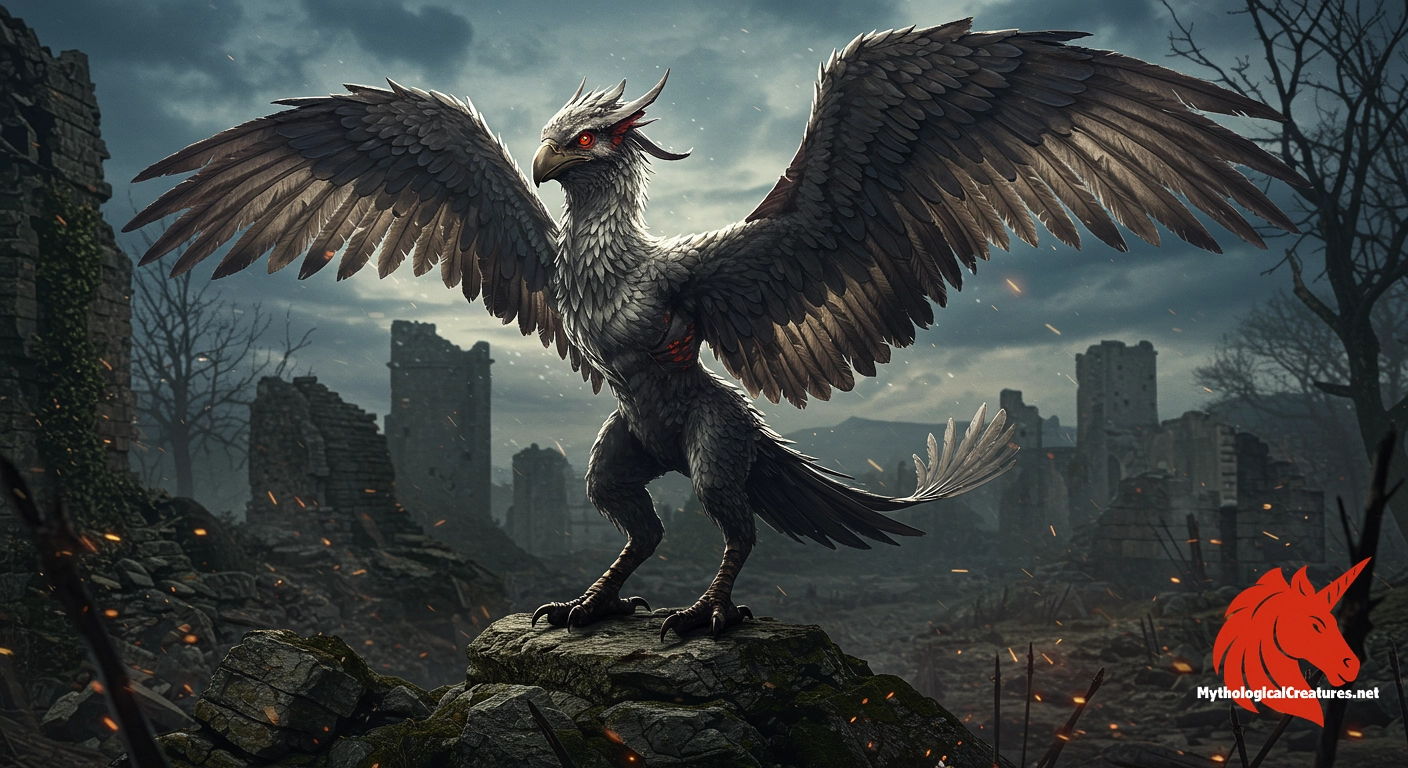Halphas: Halphas is a demonic entity listed in the Ars Goetia, ranked as an earl, who manifests in an avian form reminiscent of a hoarse-voiced dove or stork.

Halphas
Halphas - Halphas is significant for his role in inciting warfare and commanding legions of spirits, reflecting the interplay between demonic influence and human conflict.
Origins & First Encounters
Halphas occupies a significant position in the arcane world, emerging from medieval grimoires as a demon whose character combines both martial might and enigmatic wisdom. First attested in texts such as the Ars Goetia and Pseudomonarchia Daemonum, his legacy has been enriched over centuries by esoteric interpretations. Known by various names including Malthas, Malphas, or Malthus, his multiple designations underscore the layered nature of his myth. He is frequently identified as an earl among demons, a title that hints at both authority and strategic influence. His attributed role in supplying armaments and directing battles lends him an air of utilitarian menace. Stories of Halphas underscore his dual capacity to spread discord on the battlefield while also acting as a mysterious keeper of ancient wartime lore. The demon’s origins are deeply interwoven with European occult tradition, capturing the imagination of those intrigued by the confluence of mysticism and military strategy. The evolution of his character reflects the broader cultural fascination with spirits that blur the line between destruction and calculated power. His myth provides insight into how early occultists sought to explain and manipulate the forces of war and misfortune. As a result, Halphas remains a complex figure whose narrative continues to evoke both caution and curiosity.
Source Texts & Tale Variants
The primary literary sources that mention Halphas are seminal grimoires and demonological texts from the medieval and early modern eras. His appearance in the Lesser Key of Solomon firmly establishes his role in the supernatural hierarchy, where authorities assigned him 26 legions of spirits. The Pseudomonarchia Daemonum by Johann Weyer presents him with subtle variations, listing him in a slightly different position in the hierarchy. This variance is further compounded by editions spoken of in the Crowley/Mathers tradition, which offer additional name forms such as Malthus or Malphas. Works like Skinner & Rankine’s edition provide another layer of nuance by detailing his association with warfare and his partnership with opposing angelic forces. The Dictionnaire Infernal by Collin de Plancy adds yet another perspective, sometimes depicting him with the physical traits of a stork rather than a dove. Each manuscript contributes its own set of details, allowing later interpreters to piece together a multifaceted image of this demon. The survival of these texts through generations highlights a legacy of secrecy, adaptation, and reinterpretation in occult literature. The differing accounts serve as a testament to the evolving nature of demonological narratives. Ultimately, these varied sources create a rich tapestry that continues to influence modern interpretations of his character.
Form & Powers
Descriptions of Halphas often centre on his striking avian characteristics, which provide a vivid visual metaphor for his dual nature. He is traditionally depicted as a hoarse-voiced stock dove, a portrayal that imbues him with a sense of both fragility and ominous intent. In contrast, certain accounts liken his form to that of a stork, emphasising elongated limbs and a pronounced, almost regal beak. The physical imagery associated with him often blends the natural elegance of birds with the foreboding symbols of destruction and warfare. His feathers and plumage are described in a manner that suggests both a deceptive softness and an underlying strength ready to be wielded in conflict. Some texts introduce the idea that his form is interlaced with symbolic weaponry, hinting at his role in arming towers and fortifications. This amalgamation of organic and martial elements sets him apart from more straightforward depictions of demons. Variations in his size and demeanour across different sources indicate that his physical representation was subject to the creative reinterpretations of occult scribes. The merging of natural forms with the imagery of military might invites a deeper reflection on how physical appearance can symbolise inner power. Such layered depictions underscore the persistent and evolving fascination with his iconography in demonic lore.
Regional Faces
Regional interpretations of Halphas reveal intriguing variations that reflect the diverse cultural milieus in which his myth was retold. In many European traditions, his image is anchored in grimoires that emphasise his martial responsibilities and his role as a provider of weaponry. French texts often embellish his form with stork-like features, a depiction that resonates with local artistic traditions and symbolic language. German accounts, on the other hand, sometimes focus more on his avian qualities, framing him as a harbinger of both war and subtle misfortune. In some Iberian manuscripts, the narrative surrounding Halphas is interwoven with local superstitions, resulting in a blend of indigenous folklore and imported occult motifs. Eastern European sources occasionally reassign his attributes to align with regional beliefs about fate and divine retribution, highlighting an adaptability that accommodates varying cultural emphases on conflict. The fluidity of his representation across these regions speaks to the broader trend of mythological syncretism where similar archetypes are reshaped to resonate with local contexts. Local adaptations may also symbolise historical experiences of warfare, where the demon’s attributes serve as metaphors for societal tensions and military strife. Thus, his role is not static but evolves with the cultural narratives of the communities that retell his story. This regional diversity enriches the overall tapestry of his myth, making him a truly multifaceted figure.
Cultural Parallels
A cross-cultural examination of demonic figures often places Halphas in a broader context alongside other mythological entities associated with war and chaos. His dual depiction as both a gentle bird and a formidable warrior is a motif that finds resonance in various cultural narratives, where similar contradictions are celebrated. Comparable figures in other traditions often combine the symbolism of flight and warfare, suggesting a universal appeal of the duality inherent in nature and conflict. In some occult frameworks, Halphas is viewed in parallel to archdemonic beings whose roles extend beyond simple malevolence to incorporate strategic influence over battles. The interplay of nurturing imagery and violent undertones in his depiction is reminiscent of several mythic archetypes that embody the paradoxes of power. Comparative analysis reveals that many cultures have conceived of spiritual entities that are as capable of bestowing resources for warfare as they are of inciting destruction. This duality serves as a bridge between the notions of divine benevolence and infernal retribution found in other mythologies. His narrative, when placed alongside similar figures from Islamic mysticism or Eastern European folklore, emphasises the common human endeavour to personify the unpredictable nature of war. These cultural parallels not only underscore shared themes across traditions but also highlight unique regional nuances. In essence, Halphas exemplifies the melding of natural symbolism and martial energy found across the tapestry of world mythologies.
Legacy & Modern Evolution
The evolution of Halphas’s myth mirrors the broader shifts in cultural and occult thought from medieval ritualism to contemporary esoteric exploration. Early grimoires presented him strictly as a demon of war, a role that positioned him among the utilitarian forces of chaos and strategy. Over time, his character has been reimagined by modern occultists, who often view his dual nature as an allegory for internal conflict and the complexities of power. His image now finds a place not only in traditional demonology but also in modern literature, art, and digital media, where reinterpretations infuse him with symbolic layers relevant to contemporary audiences. The metamorphosis of his story reflects a shift from literal interpretations rooted in ritual magic to more metaphorical understandings of warfare and inner turmoil. Modern portrayals sometimes present him as a cautionary figure, whose involvement in battles serves as a reminder of the inherent risks of unchecked ambition. This recontextualisation illustrates how ancient symbols can be reinterpreted to speak to modern experiences and ethical dilemmas. The enduring fascination with Halphas highlights the timeless quality of myth to evolve and adapt to changing cultural landscapes. Even as new generations of occult practitioners revisit his story, his legacy continues to provoke both scholarly debate and popular intrigue. In contemporary occult circles, Halphas remains a potent symbol of the transformative and often paradoxical nature of power.
Interesting Fact
Halphas' ambiguous avian depiction, varying between a stock dove and a stork, highlights the diverse interpretations of demon forms in occult literature.
Quick Creature Info
Our Mythic Legendary Rating:

Also Sometimes Known As:
Habitat:
Supernatural Powers:
Physical Attributes:
Abilities:
Behavior:
Lore:
Related Creatures, Tales or Lore
- AAstaroth
- BBaal
- PPaimon
References
Discover Another Mythical Legend You May Not Have Heard Of?
Uncover the mysteries of ancient folklore and expand your knowledge of legendary beings from cultures around the world.
Dare to Meet the Lainingthou Sanamahi....
Mythical Disclaimer: The images and data on this site are derived from various historical and literary sources, but we have found that many myths often have multiple versions and interpretations across references, sometimes contradictory. As a result, these creature depictions are artistic interpretations—imaginative blends of folklore, legend, and a dash of AI guesswork. Because creature descriptions vary widely, our illustrations and accompanying information represent our best effort to honor mythology while bridging creative gaps. Enjoy these interpretations—just remember, we've done our best to respect the stories and validate available data, but in the realm of mythology, details often shift, imagination leads the way, and nothing is ever set in stone!
Curated by the Mythological Creatures Team (rev. May 2025)
